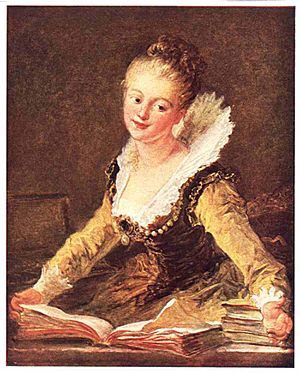Anne Louise Brillon de Jouy facts for kids

Anne Louise Brillon de Jouy (née Boyvin d'Hardancourt; 13 December 1744 – 5 December 1824) was a French musician and composer.
Life
She was born in Paris, played and composed for the harpsichord and the piano, and lived in Passy.
Her compositions number almost 90. Most are instrumental chamber music, including solo and accompanied keyboard sonatas; sonatas for cello, violin or harp; trios for two harpsichords and piano; and vocal music. She wrote music to perform herself and with the two Brillon daughters, Cunégonde and Aldegonde. The piano music written for her own performance is virtuosic, incorporating new keyboard techniques and sonorities along with a number of innovations are usually associated with later pianist-composers such as Czerny and Liszt. Her manuscripts are in a private French collection and in the American Philosophical Society library in Philadelphia.
When Benjamin Franklin arrived in Paris in 1777 as ambassador from the American colonies, he lived near the Brillon residence and was a welcome guest at her distinguished salon, which he described as ‘my Opera’, where there are ‘little Concerts’ with music and singing. After his return to America in 1785, he and Mme Brillon maintained an active correspondence.
About 1767, Luigi Boccherini composed in Paris the Six Sonatas for Pianoforte and Violin op 5. The set was dedicated to Anne Louise Boyvin : "She is one of the greatest lady-players on the harpsichord in Europe. This lady (...) plays the most difficult pieces with great precision, taste and feeling (...). She likewise composes, and she was so obliging as to play several of her own pieces both on the harpsichord and pianoforte accompanied with the violin by M. Pagin, who is reckoned in France the best scholar of Tartini ever made." This remark about her performing on the pianoforte is interesting: At the time Boccherini wrote his Six Sonatas op 5, the pianoforte was still a relatively new instrument, but Anne Louise Brillon de Jouy inspired him to write the keyboard part specifically for the new instrument, including dynamic markings. When the sonatas were published in 1769, the reference to the pianoforte was replaced by "harpsichord" and many dynamic markings were removed because the harpsichord was still the dominant keyboard instrument, and the publisher had to adapt the sonatas for commercial reasons.
In 1777, she composed the Marche des insurgents (March of the Insurgents) to celebrate an American victory in the American Revolutionary War.
She died at Villers-sur-Mer, Calvados, aged 79.

